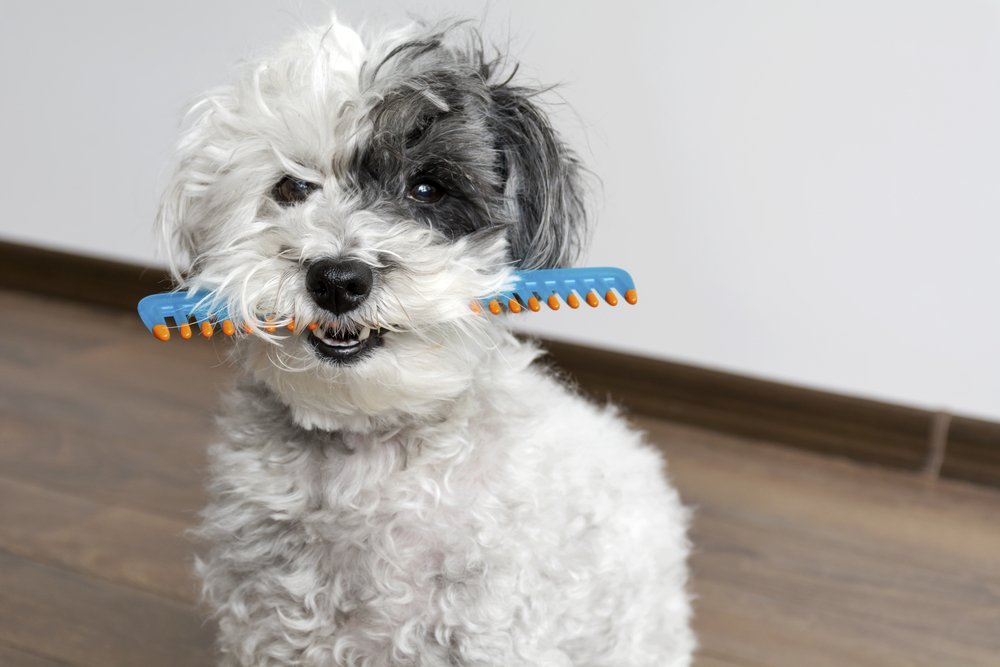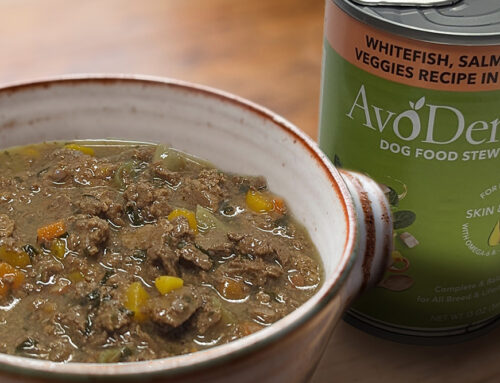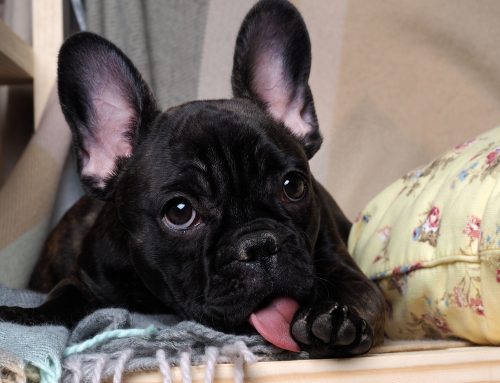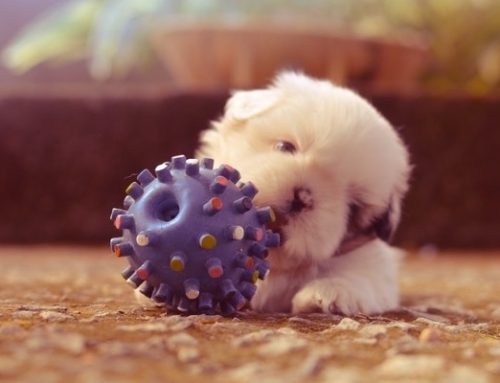Have you ever thought about grooming your dog yourself? Maybe your dog is in between grooming visits, or you just want to save a little money. Basic dog grooming is a DIY project you can tackle at home. As an added bonus, this is a great opportunity for you to bond with your dog. There are a few things to know before you start.
You Need a Few Tools
Depending on what you’re going to tackle, you need a few tools and supplies:
- Brush (slicker or pin, depending on your need)
- Flea comb (helps remove dirt and dust from the coat)
- Clippers or scissors (if you’re clipping your dog’s coat)
- Nail clippers or grinders (to keep nails trimmed)
- Shampoo (formulated for dogs)
- Towels (for drying off after a bath)
Taking Care of the Skin and Coat
Keeping your dog’s skin and coat healthy is the first (and easiest!) thing you can do. Even if your dog has a short coat, he will benefit from a good brushing. If your dog has a short coat, you may only need to brush him once a week. Dogs with longer coats may require daily brushing. Short-haired breeds might need only a light going-over with a rubber hound glove and a soft brush.1
Start by removing loose hair with a slicker brush. A flea comb can help you remove tangles and let you get a closer look at your dog’s skin. Depending on your dog’s coat type, you may find other brushes helpful, like pin brushes, bristle brushes, or rakes. Good nutrition goes a long way to help your dog have healthy skin and a healthy coat. Feed your dog a high-quality food like AvoDerm Natural Grain Free Salmon and Vegetables Recipe.
Trimming the Nails
Trimming your dog’s nails can seem intimidating, but it doesn’t have to be. There are three types of tools to help you trim your dog’s nails: scissor-type clippers, guillotine-style clippers, and nail grinders.2 If you’re clipping the nail (scissor-type or guillotine-style), hold your dog’s paw firmly in your hand and clip straight across the nail. Make sure you don’t clip past the curve of the nail, or you may cut the quick, which can bleed.3
A nail grinder is less likely to cut the quick and gives a smoother edge to the nail. This may be a better option if you’re nervous about clipping your dog’s nails. Hold the dog’s paw firmly in your hand, and “rock” the grinder gently back and forth across the nail to give a smooth edge. Again, be careful to not go past the curve of the nail to avoid the quick.4
Talk to your vet if you want a demonstration, or if you need tips to calm your dog if he’s nervous about nail trimming. Consider letting your dog lick peanut butter off a spoon to distract him while you trim his nails.
Bathing Your Dog
Your dog doesn’t need a bath every day, and some can go weeks between baths. It all depends on your dog’s lifestyle and individual needs. Before you bathe your dog, make sure you brush your dog’s fur to remove any loose dirt or fur and to detangle any mats. (Mats that get wet can be tricky to detangle and often need to be cut out.)
Depending on the size of your dog, you can bathe your dog in a sink, a bathtub, or a shower. You may even want to bathe outside in a tub or bucket. Wherever you bathe him, make sure you can keep him safe and secure so he won’t jump out.
First, rinse your dog’s coat thoroughly using water that isn’t too hot or too cold. Make sure the coat is completely wet. If your dog’s face isn’t very dirty, use a damp rag to remove any loose dirt or spot clean his face, eyes, and ears. This will help you keep shampoo out of his eyes and ears during the shampoo and final rinse stages. (Tip: This is the perfect opportunity to check his eyes and ears for signs of infection or injury.)
Once your dog is fully wet, massage shampoo into the fur and follow the directions from the manufacturer. If your dog has itchy or dry skin, choose a shampoo specially formulated to help condition and soothe the skin and coat.
After your dog is all lathered up, rinse your dog’s coat thoroughly to remove all the shampoo. Start rinsing (with cool water) at the highest part of the neck and work your way down his back. Once you’ve got the shampoo off the neck and back, move to his belly, then his tail. Save the legs and feet for last. When you rinse this way, you won’t have to rinse any areas a second time.
A microfiber towel does a great job of removing excess water from your dog’s coat. Once you’ve removed a good portion of the water, let your dog air dry. Don’t use a human hair dryer on your dog, as it may scald his skin.
Clipping His Coat
Sometimes your dog needs a trim in between grooming appointments, or you may feel a bit adventurous and want to try clipping your dog yourself. Before you start clipping, brush out your dog’s coat. Consider bathing him, too. Freshly cleaned fur makes the clipping part easier.
If your dog gets nervous at the sound of the clippers, introduce him to the clippers when they’re off. Then help him get used to the noise and movement of the clippers without using them on his coat. Speak to him calmly (and maybe offer a treat or two) to help during this process. You can also purchase quieter clippers that make less noise.
The easiest way to cut your dog’s fur is to follow the natural growth of your dog’s coat. Start at the neck, then work down in long, gentle motions and clip in the direction of the coat. Make sure you keep the blade at an angle so it glides across your dog’s skin.
When deciding how short to clip your dog’s coat, keep in mind the length of coat your dog usually has. If your dog has long fur, you want to leave some length. A longer coat helps protect him from sunburn, so don’t give him a buzz cut. Also, remember that you can always clip off more later, but you can’t glue it back on if you cut it too short.
If you’re feeling extra adventurous, use curved or textured scissors to touch up your dog’s coat. This helps make the fur look less clipped. You can use scissors to trim carefully around your dog’s face and ears. Also, check his footpads. If fur is growing too long in his footpads, use small grooming scissors to trim this area.
Brushing the Teeth
If you’re not already brushing your dog’s teeth, there’s no time like the present to get started. It may take some time to introduce your dog to a canine-safe toothbrush and toothpaste, but routine toothbrushing a couple of times a week can help prevent long-term oral health issues,5 which protects his overall health (not to mention his breath!). If your dog doesn’t take to brushing his teeth, you can find oral chews and breath fresheners to help keep plaque at bay.
Whether you choose to stick with the basics, or you decide to set up a mini dog spa, this is a special time to spend time with your dog, so make it fun! When your dog views grooming as a positive experience, it makes it easier for both of you.
- Banfield Pet Hospital. “Basic pet grooming 101,“ https://www.banfield.com/pet-healthcare/additional-resources/article-library/everyday-care/basic-pet-grooming-101
- Donavan, Liz. “How to Pick Dog Nail Clippers,” AKC.org, 12 March 2015, https://www.akc.org/expert-advice/health/how-to-pick-dog-nail-clippers/.
- Meyers, Harriet. “How to Trim Your Dog’s Nails Safely,” AKC.org, 12 May 2020, https://www.akc.org/expert-advice/health/how-to-trim-dogs-nails-safely/.
- Baines, Laura. “The Ultimate Safety Guide to Using a Dog Nail Grinder,” certapet.com, 16 April, 2020, https://www.certapet.com/dog-nail-grinder/.
- ASPCA. “Dog Grooming Tips,” https://www.aspca.org/pet-care/dog-care/dog-grooming-tips





